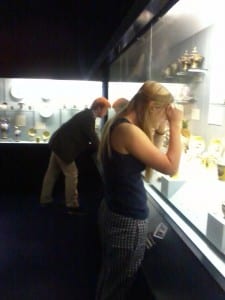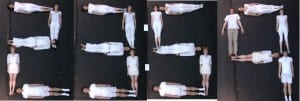“So much of our time is spent in preparation, so much in routine, and so much in retrospect, that the amount of each person’s genius is confined to a very few hours.”
– Ralph Waldo Emerson
As with all performance based pieces, there are many things which could have been improved and should have been developed further in our final product. Our piece was far from perfect, however, I think that we explored our ideas effectively and presented our audience with visually interesting ideas, whilst transforming our chosen space in a unique and informative way.
Strengths and Weaknesses
Unfortunately the opening of our piece went wrong, with the irony of our own clock not working which meant we started out of time to our planned structure. That being said, we recovered quickly and efficiently and got back in time with each other.
In my opinion, the projection of our human clock was the biggest strength of our work. It stood out within the darkness of the gallery, and drew much of the audiences attention. Although this projection had a great impact, I don’t think the projection of the pineapple worked at all. Firstly, the image wasn’t clearly identifiable and this was down to the filming of the pineapple. We should have filmed it for a longer period to show the decomposition process in its entirety. Secondly, I think the positioning of the projection was wrong and we should have had the image projected underneath the human clock. If we had synchronised it with the timing of the clock, then it would have slowly decomposed over the course of the day, demonstrating the effects of time in a much more direct manner.
Another strength of our piece was the clock puzzle. It juxtaposed the two ideas of ‘work’ and ‘play’, because although it represented the ‘work’ part of our daily routine, we were ultimately doing a jigsaw puzzle, which is more ‘play’. This created an interesting dimension to our piece as it questioned the boundaries between these two actions. If we took that puzzle out of our chosen site, and put it in another space, would it have a different effect?
Audience Reaction
This was the first time we had put all our performance elements together, and had a real audience to respond to. It was interesting how different groups of people reacted depending on where we were positioned within the room and what we were doing. During the process of creating the puzzle we had people intrigued by what the final image was, and one man kept coming back to watch our progress along with his two daughters. It would be interesting to see how the dynamic of the space would have changed further if the puzzle had been bigger and filled the entire floor. I’m glad that we got a wide range of age groups witnessing our work because they all had a different approach. The children who entered our space got excited and looked eager to join in when we were creating the puzzle. However the moment we started miming, several children refused to enter and became fearful of the space, because our movements had become unnatural and mechanical. On the other hand, the older generation were more inquisitive and also nonchalant, with some members just waltzing right in and completely ignoring us! At one point, we were all sat in a line by the entrance watching the human clock, and you could see the audience were more wary of entering the space because of how we had positioned ourselves. We had manipulated the audience to feel like they were imposing and that the space solely belonged to us. This reminds me of the work of Susan Bennett whose work discusses the relationship between the audience and distance between performers:
‘Distance is intrinsic to art….the deliberate manipulation of distance is to a great extent, the underlying factor which determines theatrical style.’
(Theatre Audiences: A Theory of Production and Reception, Susan Bennett, Routeledge London, 1990)
Indeed, this is relevant to our piece as our distance between our audience varied throughout the day, changing our space and even atmosphere of the room. Our chosen space was claustrophobic anyway so to have close proximity to our audience intensified this feeling of confinement, and our style switched between the natural and unnatural. Perhaps we should have rehearsed much more with an audience leading up to our final performance, in order to discover more ways in which to involve or distance our audience further.
Concluding Remarks
This performance process has developed over a long time, collaborating many ideas and exploring different techniques. I felt we portrayed our ideas on time quite effectively, both visually and practically. However, I think we over complicated our ideas, and it would have been more effective to have done something minimal and simple which progressed over the duration of the day, rather than having a set structure of many different things. As a performer, it was a challenge to be focused for 6 hours continually but this work has taught me many skills which I would like to develop in my next project.
Works Cited
Bennett Susan, Theatre Audiences: A Theory of Production and Reception, (Routeledge London, 1990)







